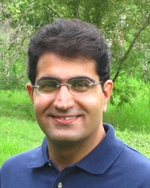NASA's Prestigious Earth and Space Science Fellowship Awarded to CEE Doctoral Student
Ali Behrangi receives two-year renewable $60,000 fellowship to continue his advanced research in precipitation
 Ali Behrangi, a third-year civil and environmental Ph.D. student, has been awarded NASA’s Earth and Space Science Fellowship (NESSF), which aims to ensure the continued training of a highly qualified workforce in disciplines required to achieve NASA’s scientific goals. Behrangi was selected from a highly competitive pool of students in the area of Earth Science research to receive a two-year award – with the option to extend the fellowship to a third year – and will receive $30,000 annually to continue his research in precipitation estimation using remotely sensed satellite images. Behrangi is the first student in The Henry Samueli School of Engineering to receive this distinction.
Ali Behrangi, a third-year civil and environmental Ph.D. student, has been awarded NASA’s Earth and Space Science Fellowship (NESSF), which aims to ensure the continued training of a highly qualified workforce in disciplines required to achieve NASA’s scientific goals. Behrangi was selected from a highly competitive pool of students in the area of Earth Science research to receive a two-year award – with the option to extend the fellowship to a third year – and will receive $30,000 annually to continue his research in precipitation estimation using remotely sensed satellite images. Behrangi is the first student in The Henry Samueli School of Engineering to receive this distinction. The fellowship program allows NASA to solicit research involving data collected by space-based instruments during current and past NASA missions, relevant ground-based data and laboratory experiments, and theoretical modeling.
Under the advisement of Soroosh Sorooshian, Ph.D., distinguished professor of civil and environmental engineering and Earth system science, and director of the Center for Hydrometerology and Remote Sensing (CHRS), Behrangi has developed a Precipitation Estimation Method from Satellite-based Multi-spectral Analysis (PERSIANN-MSA) to study the role of multi-spectral data and cloud textures for both the delineation of the areal extent of precipitation, and the estimation of the precipitation rate. As a result, he has shown that multi-spectral data can be an important alternative in improving precipitation estimation using Geosynchronous-Earth-orbiting (GEO) satellites.
Behrangi’s follow-up research focuses on the integration of more accurate precipitation estimations obtained through passive microwave (PMW) sensors onboard Low-Earth-Orbiting (LEO) satellites, into more frequent precipitation estimates obtained through visible/infrared (VIS/IR) sensors onboard GEO satellites. The anticipated launching of NASA’s Global Precipitation Measurement (GPM) mission and the increasing number of spectral bands in recently launched and future geostationary platforms, will provide greater opportunities for investigating new approaches to combine multi-source information to improve consistency, accuracy, coverage, and timeliness of high-resolution precipitation estimates, all of which are important to many research activities, and have a wide range of applications at scales ranging from global-climate modeling to local weather forecasting.
In this regard, Behrangi is currently working on combining GEO and LEO satellite information in a manner that allows for the consistent integration of the more accurate PMW precipitation estimate into a short-term cloud evolution process, which can be inferred from GEO imagery. This will be accomplished by integrating an advanced Lagrangian cloud tracking technique to explicitly incorporate the effect of cloud growth, deformation, and dispersal during the interval between two microwave overpasses; using a precipitation estimation model that incorporates multi-spectral imagery from GEO satellites to supplement rain retrieval information from VIS/IR data; and, employing a sequential updating procedure - specifically, Kalman Filter - to update the model parameters.
Behrangi received B.Sc. and M.Sc. degrees in civil and environmental engineering, with an emphasis in hydrology and hydraulics, from Sharif University of Technology in Iran. He started his doctoral studies at UC Irvine in 2005, focusing on precipitation estimation using satellite imagery. Behrangi is the recipient of several awards, including the 2006 Iranian American Society of Civil Engineers (IASCI) Student Award, the 2007 Samueli School Research and Travel Grant, and the Seventh Annual “California: Prosperity Through Technology” Industry Research Symposium Fariborz Maseeh Best Student Research Poster Award. He was also selected for the 2008 NASA Graduate Student Summer Program (GSSP) to pursue his research at NASA’s Goddard Space Flight Center (GSFC) in Maryland.
“I would like to thank the CHRS faculty and staff, particularly my advisor, Dr. Sorooshian, and my co-advisors, Dr. Kuo-Lin Hsu, and Dr. Bisher Imam. Dr. Sorooshian has always encouraged and facilitated my research partnerships and activities with scientists and organizations, in addition to our own research group, which has given me an excellent opportunity to learn and collaborate. In addition to his continued support, this award will have great impact on pursuing my research,” Behrangi said.
